Home » Pest Control
Category Archives: Pest Control
The ‘Sugar Glider’ Possums
How To Get Rid of Possums / Opossums
When an opossum (or the more common name possum) bares its mouthful of jagged teeth at you, your first instinct is probably to run away, wondering how to get your yard back from these nuisance animals.
Luckily, there are a few different ways to get rid of these sneaky night dwellers, and we’ve listed them below Whether you’re looking for a “live and let live” solution or you’d rather take more a direct, engineered approach to kicking the possums to the curb, we’ve got solutions for that scenario, too.
How To Naturally Remove Opossums?
Okay, so you don’t want to hurt the opossum or do anything inhumane—you just want it off your property. Keep reading for strategies you can employ to make an opossum want to leave your home on its own in a matter of a few weeks.
Eliminate Its Food Sources
The driving force for any possum to take up residence in an area is almost always going to be food. Opossums are known to eat just about anything, and will scavenge through your backyard to find pests, dead animals, old food, rotting wood, and even snakes to eat!
Clean Up Your Garden
In addition to insects, spiders, and slugs, did you know that possums will happily munch on weeds and wilting plants? Like humans, the opportunistic possums are omnivores, meaning that they eat both plants and meat. If you keep your yard manicured and properly trimmed, you remove the opportunity for possums to nestle in your garden and make it their new home.
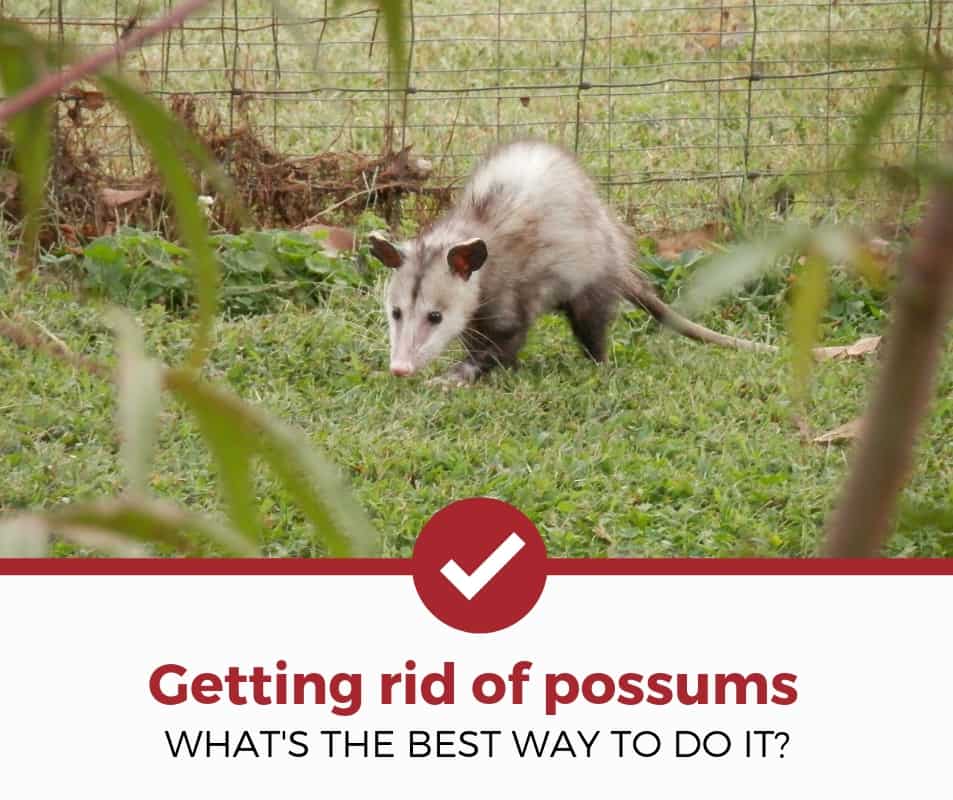
How to Get Rid of Possums: Comprehensive Guide
Possums and opossums seem to be cute and quite friendly when you see them in pictures. But, when they get on your territory and spoil the harvest or even settle inside your apartment, they don’t look that cute anymore.
Looking for a food source, possums can damage your crops, trees, as well as feed on your leftovers, making complete chaos while turning the trash bin over. If you faced such a small but rather disturbing problem, let me help you. As a pest consultant and exterminator, I can give you some useful advice.
How to Determine a Possum?
The possums are small marsupial mammals that look like rodents. The first representatives of this species appeared in the Cretaceous period, which is about 100 million years ago, and have not changed significantly since then. The appearance of a possum is very similar to a rat.
Possums can be confused with rats and mice due to their narrow muzzles and long bare tails, which also work like animal’s fifth paw. Because possums live on the trees, their tails help them to move around and cling to branches.
The possum itself is a relatively large animal. The length of its body is up to 45 centimeters, and another 30-32 takes the tail. The female individual has a bag on its stomach to carry the cubs like a kangaroo. A newborn possum is born completely blind and weighs only 5 grams. The mother carries its offspring in a bag for 60 days until it is strong enough.
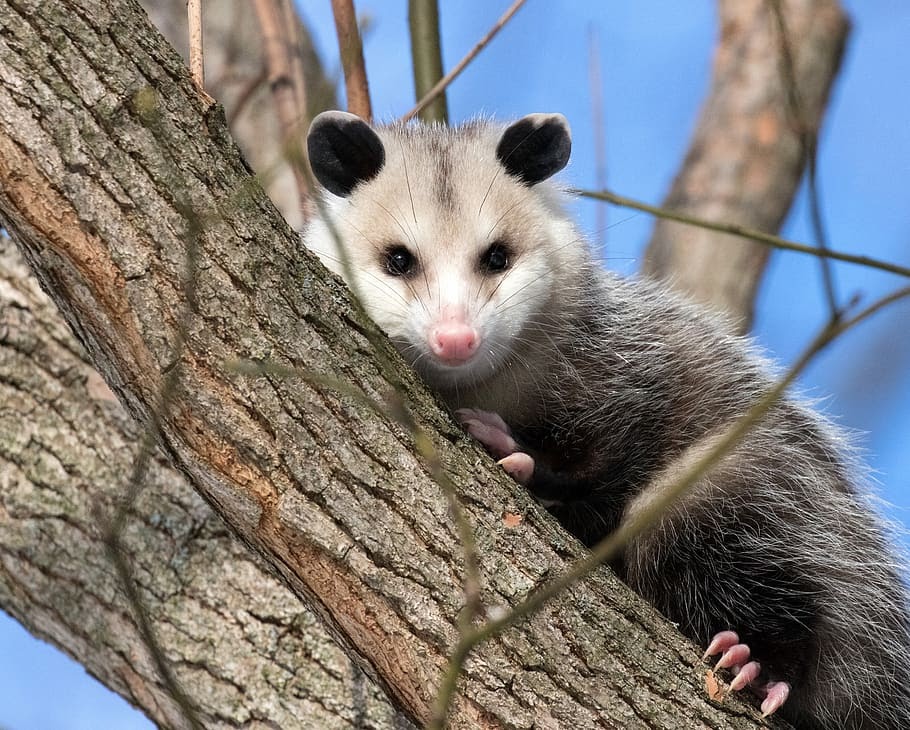
Opossum Control: How To Get Rid Of Opossums
This page is a general Opossum control guide. Using the products and methods suggested you will get control of Possums. Follow this guide and use the recommended products and we guarantee 100% control of Possums. Consult your local and state guidelines to see if the Possum is a protected species in your location before applying control and proceed with caution as Opossums can be dangerous.
Have you been startled by the appearance of an oversized rodent? It likely was an Opossum. Opossums or “Possums” are about 2 feet long and measure about 6 to 15 pounds. They have long tails and sharp claws. They have a pointed snout and sharp teeth. Possums will often hide inside tree trunks and places that provide them with harborage. They are most commonly seen around dumpsters, close to wooded areas, and near homes and structures (like basements and garages), especially at night.
Possums are constantly on the hunt for food and will venture onto residential areas not only looking for food (garbage, fruits, vegetables, worms, etc.) but also looking for harborage areas which means crawl spaces, garages, and wall voids in the home. Possums can wreak havoc in gardens and backyards by feeding on crops and vegetables. They have been known to get into fights with pets. Aside from this, they also carry a high number of diseases such as tuberculosis, tularemia, spotted fever, Chagas diseases, leptospirosis
Identification is the first step in control. Before you can treat you need to make absolutely sure you’re dealing with Opossums. Below you can find the common characteristics that set Possums apart.
Opossums weigh between 6 to 15 pounds and are typically 2 feet long from the snout to the tail.
They have silver-colored fur with white tips, a white face, black paws and ears.
Their feet have five toes and sharp claws.
They have a long pointy snout.
An opossum will “play dead” when they are threatened. The animal will look – and even smell – like they are dead. They will not move, their mouths will be open, and their anal glands will secrete an odor. This is a defense mechanism that can last between a few minutes to a few hours.
An opossum is a scavenger and mainly feeds on carcasses and plants, but they are adaptable and will also consume small animals, insects, and sweet foods. Take caution when approaching or handling this animal. They are great climbers and are able to swim.
Where To Inspect
Indoors you’re looking in wall voids, cracks and crevices, basements, garage and attics. Possums are most likely in your basement looking for shelter. If you have any clutter or storage bins in your garage, they are most likely near these particular spots. Search the corners and crevices of the garage as well. Outdoors you’re looking in your yard, near your garbage cans, and close to trees. If you have a crawl space or any type of opening under your house, possums may be there as well.
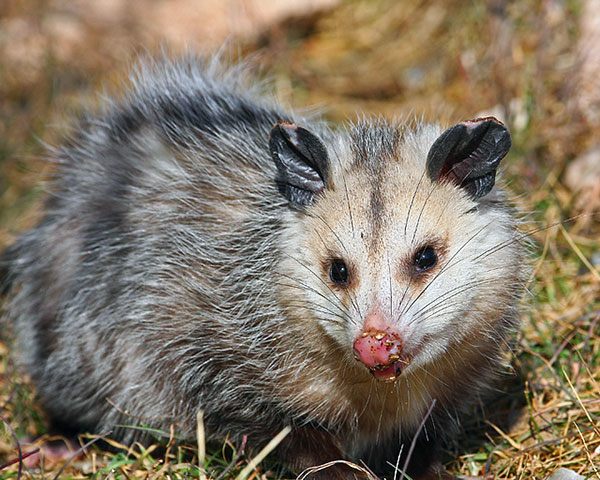
How To Get Rid Of Possums
You have a problem. You have discovered that something new has taken up residence on your property. It’s not the typical pests that households regularly encounter, so momentarily, this critter has you on the back foot.
Pretty soon, you work it out; you have a resident, Possum. So how do you now how to get rid of a possum in backyard. You decide to look it up on the Internet and check out the implications. This may lead you to be even more confused as there are mixed feelings about Possums.
The great debate and one that should be discussed
The humane society starts the debate by telling you that Possums are not much of a problem and are often accused of doing things they never actually did. That they are no threat to humans, so you should welcome them, or at the very worst deter them, so they move on. They may seem scary when they crouch there with their mouth open and hissing at you, but it’s just a bluff.
If that fails, they usually switch to plan B and pretend they are dead. Fighting is pretty low on their agenda. Then, of course, the Pest or Opossum Control companies chip in their point of view, which is that they should all be killed, done away with, exterminated! But there again, they would say that, wouldn’t they?
Possums are not a Rodent like rats; they are the only Marsupial in the USA. They are smallish wild animals and can reach 13lbs. Possums that have become urbanized have become decidedly fatter than their country-cousins.

How to Get Rid of Possums Naturally
So, you’ve got a problem with possums. And you need to get rid of possums. Nice. Possums can be the ugliest thing you’ve ever seen, or some folks find them too cute to kill. They’re relatively quick, smart, agile, and love to eat your garbage. They’re also relatively large and can destroy your wiring, car, woodwork, and even your house.
Possums are quite distinctive from other rodents you may find in the yard. Compared to rats and mice, they’re a lot bigger, have a much longer snout, and a longer tail. They’re the only marsupial native to North America. They tend to have darker fur, typically silver and black with a hairless prehensile tail that they can use to grapple objects and hang from trees. They’re also decent climbers with their rear pair of legs.
Signs that you have possums
Possums are nighttime creatures, so finding them in the act is difficult. You’ll often find possum droppings, which are about 2-3’ long and look similar to cat or dog feces. This type of dropping typically shows up where they feed and spend most of their time at during the night time, so you can kind of gauge where to set up your traps and DIY solutions to get rid of possums.
Possums and humans
Possums aren’t dangerous by nature, but they will defend themselves when threatened. They’ll fight your dog or cat over food, and they also can transmit bacteria, parasites, and other diseases to you or your pets directly or indirectly.
They can transmit a disease to your dog, which then can transmit to you. So there’s always a risk of transmission and sanitary risks. Possums are known to play dead when threatened, where they’ll literally lie on the ground for up to 5 hours in comatose. During this act, they’ll emit a nasty smell from their body. The possum isn’t actually dead, but will do its best to pretend. So be warned. Don’t be carrying this possum sound because it’ll definitely, magically, spring back to life.
Bat Control Measures For A House
Bat Removal Services
Identifying Bats
Bats are some of the most misinterpreted wildlife. When it comes to environmental benefits, bats do not receive a lot of credit. However, they serve as pollinators, seed-dispersers and help to control pests. North America is home to 45 species of bats, three of which are common in the Triangle area. Using echolocation or bio sonar, bats can find their way into the tiniest spaces. These mammals are mysterious in appearance and typically are only seen at night. They are often feared by humans, which contributes to threats to their population worldwide. Bats in the Triangle are known to form colonies in their chosen roosting areas. While in search of dark and quiet places to raise their young, bats are known to invade attics in the summertime. Each species of bat is unique and poses its own challenge for people
While bats may be fascinating creatures when they’re OUTSIDE your house, it’s necessary to know if they are IN your house. Here are some tell tale clues.
Bat droppings, or guano, can be found on the sides of your house, in attics or under the eaves. Unlike rodent droppings, which are typically dispersed, bat droppings are found in clumps and may contain insect parts.
Bats roost on the outside of the house.
A scratching noise that comes from the attic—day or night, as the bat or bats attempt to find their way out.
High pitched squeaks coming from your attic, eaves or walls.
A strong smell from the attic (from the bat droppings).
Bats fly around the outside of your home or out of your chimney at dusk.
Bat Habitats
Typically found in caves, bats can live in almost any feasible shelter. As their natural habitats diminish, many bat species choose to live in homes or storage-type buildings. It is also common for bats to roost in attics or caves. The big brown and little brown bat species of North Carolina often make noises upon exiting their roost. They also tend to have a musky odor and commonly leave droppings underneath their roosting area
Bats are great to have around your home as they eat almost 100% of their body weight every night. And sure—bats aren’t the biggest creatures, weighing in around half an ounce each—but, they live together in large groups, so the numbers add up quickly. Each night, they cut back the number of nasty mosquitos and other insects to bother you during the pleasant spring and summer nights.
Say you see the droppings but never the bats—you may be asking yourself where they roost during the day. Typically, they roost and forage in the trees and areas around neighborhoods where the insects are the worst. If you aren’t sure if they are around your home, try sitting on your porch or in your backyard in the early evening and keep an eye on the street lights. You can often find them flitting between the lights as they start their insect hunting for the night.
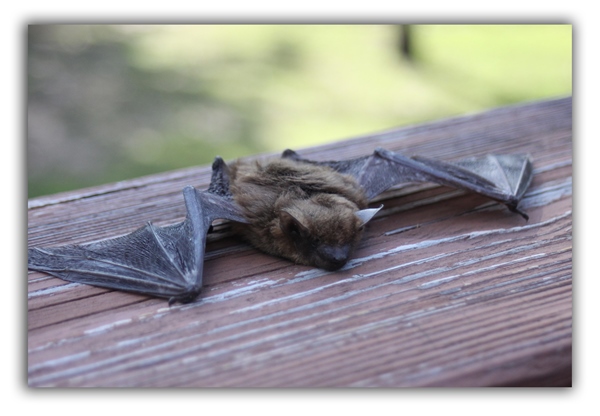
Bats
There are more than 1,100 different species of bats in the world, living on every continent except Antarctica. Each one has developed special adaptations for how it lives and what it eats. For example, 70% of all the bats in the world eat insects and many of them use echolocation in order to find food and move around in the dark. Many small insectivorous bats can eat up to 2,000 mosquito-sized insects in one night. These bats are able to eat so much because they have high metabolisms and expend lots of energy in flight.
Bats are beneficial. Worldwide, bats are a major predator of night-flying insects, including pests that cost farmers billions of dollars annually. Throughout the tropics, seed dispersal and pollination activities by bats are vital to rain forest survival. In addition, studies of bats have contributed to medical advances including the development of navigational aids for the blind.
Contact With Bats
If you are bitten by a bat — or if infectious material (such as saliva) from a bat gets into your eyes, nose, mouth, or a wound — wash the affected area thoroughly and get medical advice immediately. Whenever possible, the bat should be captured and sent to a laboratory for rabies testing.
People usually know when they have been bitten by a bat. However, because bats have small teeth which may leave marks that are not easily seen, there are situations in which you should seek medical advice even in the absence of an obvious bite wound. For example, if you awaken and find a bat in your room, see a bat in the room of an unattended child, or see a bat near a mentally impaired or intoxicated person, seek medical advice and have the bat tested.
Capturing a Bat
If a bat is present in your home and you cannot rule out the possibility of exposure, leave the bat alone and contact an animal-control agency for assistance.
How to control pests in your attic
Have you heard noises coming from your attic just after dusk? Possibly something scurrying around while you’re trying to fall asleep? You may be harboring pests in your attic.
Not only can pests keep you up at night, but they can also be responsible for property damage and they can cause health problems.
Common attic pests
Squirrels. Although squirrels typically live in tree cavities, they have been known to seek out attic space when the temperature drops. They can damage you home, building nests and creating openings. They also leave behind, body dust, feces and urine, which can cause damage or transmit disease.
Bats. Bats are able to squeeze through openings as small as 1/2 inch. Bats live in colonies and once they take up residence usually stick to the familiar space year round. A buildup of bat feces can cause illness. They have also been known to carry diseases.
Mice. Mice can fit through even smaller openings, needing only 1/4-inch gap to enter a structure. Mice can damage structures by making nests defecating and urinating. They are also disease carriers.
Rats. Rats can squeeze through openings as small as a quarter. They may also gain energy to your attic by chewing through wood, siding and drywall. Rat infestations can cause damage to your home and gardens. They also transmit diseases through the pests they carry and the feces, urine and body dust they leave behind.
Raccoons. Raccoons typically sneak through poorly screened vents and eave gaps to gain access to attic spaces. However, they have also been known to rip right through roofing materials in order to gain entry. Like all other rodents, raccoons leave behind waste, carry disease and may cause damage to your home.
Insects and arachnids. Ants, flies, cockroaches, spiders, stink bugs and more may have snuck into your attic looking for a warm place to overwinter at the end of fall. Like, rodents they leave behind body dust and droppings everywhere they crawl. They can also transmit pathogens via food contamination.
Identifying attic pests
The first step to controlling pests that have taken up residence in your attic is identifying which type of pest you’re sharing your space with.
During the day when most attic pests are inactive, take a look around your attic to determine what’s living up there. If you don’t notice any critters, look for other signs of their presence — damage to your attic, entrance gaps, scat, nests. By evaluating what your particular pest left behind, you can come closer to identifying what’s living in your attic.
Pest control experts tackling bats found inside home attics
People aren’t the only ones trying to stay warm during this winter season, bats are too and they have pest control experts busy right now.
It’s that time of year…temperatures are colder which means bats are looking for warm places to stay and that could be your house
“They actually will purposely hibernate in an attic space, if that’s available to them, they’ll be in there all summer long and when the winter comes they’ll bury themselves in the instillation and stay quiet until the warm weather shows up,” Christopher explained.
“An attic is a kind of like a cave that’s insulated, so if they’re able to get up there and tell their friends about it, one bat, two bats, three bats, turn into dozens and dozens,” Christopher noted. Christopher said people underestimate the dangers of bats getting inside houses.
“Piles of bat droppings, you could be breathing it in without even knowing it…They’re acidic, they also cause things like histoplasmosis, respiratory issues. So if you’re getting the bats out that’s great but you also want to get rid of what they left behind,” Christopher explained.
Attic Pest Removal: How to Get Rid of Overhead Guests
Attic pest removal can seem like Groundhog Day — the movie, not the holiday. No sooner do you shoo away pests that make your attic their home sweet home, than the little buggers sneak back inside.
Know thy Enemy
Wild animals living in your attic can cause damage — chew through electrical wires, shred insulation — and spread diseases, such as hantavirus and salmonella. To rid your attic of these pests, you must know exactly which critter has become your housemate. To identify — then kill or trap — the animal, you must learn to identify the shape, size, and pattern of its scat.
provides a little cheat sheet on pest poo.
Mouse: 1/8 inch long, pellet-shaped
Rat: ¼ inch long, sausage-shaped
Squirrel: ½ to 1 inch long, sausage-shaped
Raccoon: Up to ¾ of an inch wide, 2-3 inches long; sausage-shaped
Bat: ½ inch, pellet-shaped, found in piles
Once you identify the scat, follow the Centers for Disease Control’s advice on how to clean it up. Here are a few tips:
Open windows to air out the infested area for at least 30 minutes before cleanup. Don’t hang around during this part.
Wear protective gloves and masks so you don’t touch or breathe the urine- and feces-contaminated dust.
To disinfect, spray the area with a bleach solution (1 part bleach; 10 parts water).
Use paper towels to clean up the area, and then dispose of trash in a sealed plastic bag.
Ways To Get Rid Of Snakes By Changing The Environment
IDENTIFYING A SNAKE INFESTATION
It can be very difficult to realize that you have snakes on your property until the problem becomes more severe. Snakes will typically hide in confined spaces, avoiding contact with humans. We often find snakes living in crawlspaces, walls, gardens, decks, and any overgrown vegetation surrounding the property.
Snakes do leave behind a few signs of their presence. They can cause damage to structures, where they have created their nests. You may also realize that you have a snake problem if you see snakeskin in your yard or within your house
Many homeowners, unfortunately, discover that they have a snake infestation when they are face to face with a snake. If you do see a snake, give it space and call a professional as soon as possible
Banded water snakes are nonvenomous snakes that are commonly mistaken for cottonmouth snakes. These snakes have heavy bodies with both dark markings and lighter colored scales. Banded water snakes can grow up to three feet long and have broad, flat heads, which is another characteristic that gets them mixed up with cottonmouth snakes so often.
BANDED WATER SNAKE BEHAVIORS
As their name suggests, these snakes prefer to live in or near water—they are even known to be one of the strongest swimmers out of all types of snakes. It’s important to note they are typically found in fresh water sources, including lakes and ponds. While they aren’t aggressive, banded water snakes aren’t particularly friendly and will avoid contact with humans at all cost. When threatened, they may release an unpleasant odor or even bite; although their bite is not venomous it can still be quite painful.
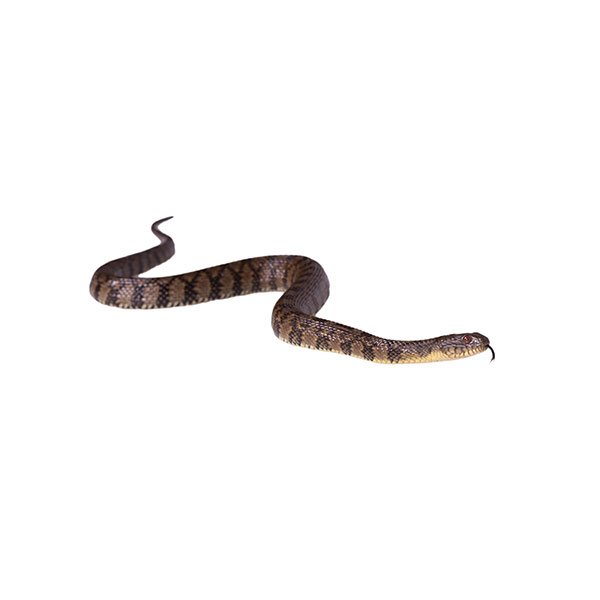
How to Get Rid of Snakes
NOTE: If venomous snakes are a known issue on your property, we strongly recommend you consult with a professional wildlife removal company prior to any snake inspection or removal efforts.
You can use snake tongs to catch live snakes and physically remove them from a given area. We highly recommend you practice with a rubber snake or piece of hose prior to trying catch a live snake with the tongs. Snake tongs come in varying lengths. While the longer length tongs will keep you further away from the snake, they are heavier and a little hard to manipulate. When trying to grab a snake with tongs, you want to aim for about 1/3 of the way down the snake’s body. Grab too close to the snake’s head and you risk injuring the snake and also causing it to struggle and possibly try to escape. Grab too far to the back end and the snake may wind up in striking distance. Once you have grabbed the snake with the tongs you should carefully and slowly lift the snake while keeping the tail of the snake on the ground and gently drag it towards the area you intend to let it go or dispatch it. If you lift the snake all of the way it will likely struggle to get away.
Pros and cons: Snake tongs can be used anywhere on your property and inside the structure which makes them very versatile. The downside is that you must come pretty close to snake in order to capture them with tongs.
The second method of capturing snakes that we would recommend is the use of snake glue board traps. Some snake glue boards such as the Cahaba brand can be used outdoors next to the foundation or under structures or in gardens. Other snake glue boards are less hardy and should only be used indoors. Snake glue boards do not contain any bait or lures. This means that the glue boards will only be effective if they are used in areas where snakes are known to frequent or use as travel paths.
Outdoors you should place the cahaba snake boards in shaded areas in gardens, near foundations, under sheds or other structures, along fence lines and other areas you have noticed snakes frequently. It is important to note that snakes like to travel with one side of their bodies touching against a vertical surface and you should place your boards so that the snake slithers into the glue board. Snake traps should be checked often if you plan to live release snakes that are captured
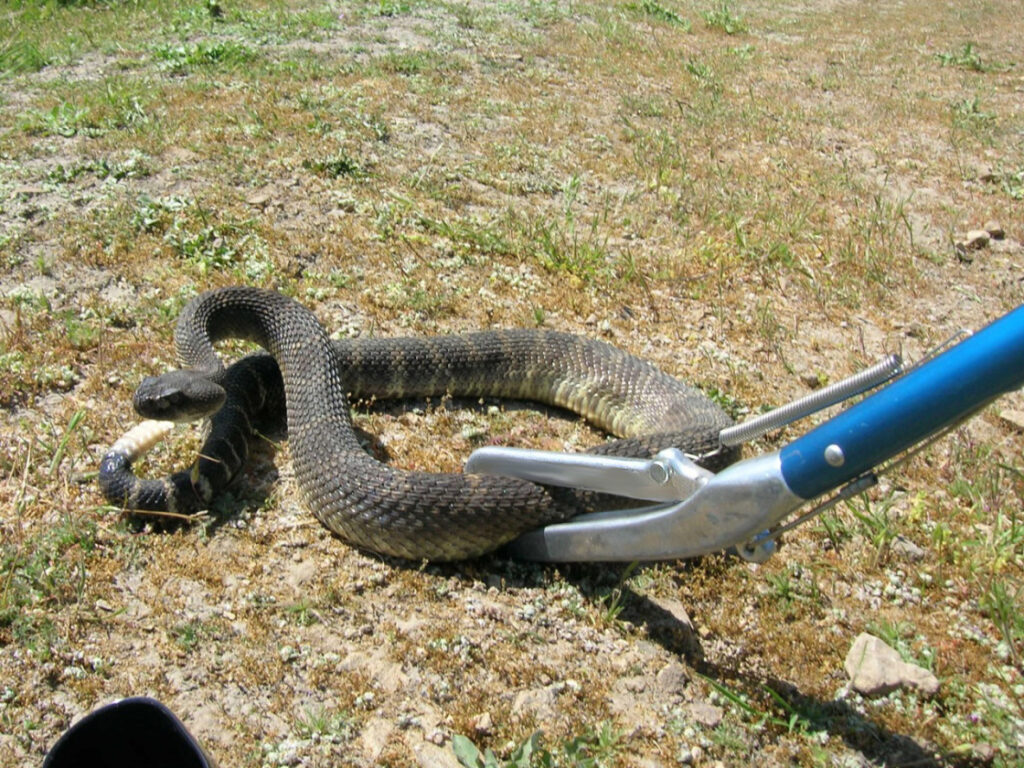
Snakes and Toads Provide Garden Pest Control
Encountering a snake in the garden causes many people to shriek or even panic. Yet snakes and another often unloved creature, the toad, are among the most effective forms of pest control. If you tolerate these herpetological visitors – or better yet, encourage their presence – you’ll be less likely to share your garden with ravenous bugs, or bottles of pesticide.
There are several snakes that make themselves at home in local gardens. The common garter snake is identifiable by the three yellow stripes running along the back. In my garden, this snake often suns itself between rows of vegetables, absorbing heat while digesting slugs, caterpillars, sowbugs, and other garden pests. Larger garter snakes (they can grow about three feet long) also eat meadow voles, which will otherwise wreak havoc on roots, tubers, and bark.
My favorite snakes are among the most docile encountered in a garden: the smooth green snake and ring-necked snake. The grass-hued scales of the green snake blend in well. Almost three fourths of its diet consists of insects, including grasshoppers, hornworms, and other crop-munching caterpillars. The ring-necked snake, named for its golden collar, stalks similar prey, but it does so under the stars. With a back the color of night, and its bright yellow belly pressed to the earth, it’s well camouflaged for nocturnal hunting
In contrast, the milk snake strikes when threatened. Although non-venomous, the milk snake’s attitude, size (it grows to three feet long) and rows of alternating reddish-brown splotches, which resemble the patterning of a copperhead or timber rattlesnake, have earned an undeserved reputation and the misnomer of “adder.” In fact, it is harmless to all but the mice, voles, other small mammals and other snakes that comprise up to 70 percent of its diet.
You can attract snakes to your garden by providing habitat: loose rock piles, old tree stumps, brush piles, prone boards, a stack of wood, and unkempt corner swales. And since pesticides can sicken and kill reptiles and amphibians, maintaining a chemical-free garden safeguards these natural predators.
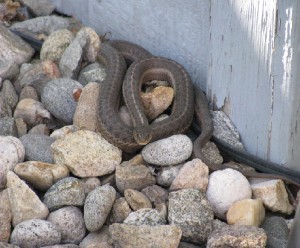
Snake Control
Non-Poisonous Snakes Identification and Description
Despite their reputation for the contrary, most snakes in the United State are not poisonous. In fact, of all the many species in the country, only a few are actually potentially harmful; rattlesnakes, copperheads, cottonmouths, coral snakes, and sea snakes.
For the most part, snakes aren’t highly adaptable creatures and require a specific habitat in order to survive. Smaller species often live underground, while others, like green snakes make their homes in trees. In generalities, snakes prefer dark, cool and damp places where food is readily available.
Although there isn’t an absolute pattern for snake infestations, there are areas that seem to be more attractive than others. Firewood that is stacked directly on the ground, old lumber piles, flower beds and gardens with an excess of mulch, disorderly basements, junk piles and barn lofts. Barn lofts are especially appealing when stored feed attracts rodents, as are attics with rat or mice control problems. Pond and river banks–especially when there are boards, tires and other items in the surrounding area, additionally with unmowed lawns and abandoned lots are also alluring to snakes.
Diet and Feeding Habits
Every snake is a predator, but diets may widely vary depending on the species. Rat snakes for example, as their name would indicates, eat primarily rodents, baby birds and eggs. Some snakes eat primarily insects, while other smaller species, like earth snakes and worm snakes, eat earthworms, slugs, and salamanders. Water snakes eat primarily frogs, fish, and tadpoles.
Damage Possibilities
Aside from frightening people, nonpoisonous snakes are completely harmless and tend not to cause damage. Once a snake or a group of snakes is identified as non-poisonous, most methods for removal are inexpensive and fairly non-invasive.

Snake Removal
When Snakes Get Into Your Home
Snake are generally quite sensitive to a human’s presence so when they get into your home, they’re not easy to spot or even realize they’re there. But once you do see one, it will surely cause a concern.
Although the majority of snakes are completely harmless, there is the possibility that the snake you’ve encountered is one of the venomous types, of which means you need to take the proper precautions for the sake of the safely of your family and pets. An encounter with a snake is not worth the cost of getting bit by a dangerous one. One of the most common areas snakes enter homes is through the openings in weeping bricks. A good percentage of the time that, and open doors are their entry points
A snake problem calls for the help of an experienced removal specialist to ensure all precautions are taken, that the snake is handled and removal humanely, and that effective prevention and control methods are devised and properly implemented.
There are some key reasons that should prompt you to hire us for a snake removal job, and they are because:
if you encounter a Mississauga rattlesnake in your home, you’re immediately at risk of being bit by it’s venomous fangs
they post more serious threats to pets and children
if they are in your home because of a food source like mice or birds, they may end up carrying bacteria with them to other places of your home
regardless of species, you can get bitten, and may require medical attention
they may sleep in areas where we put our feet or step on, and severely frighten a family member
Snakes don’t particularly like to live near humans but if they accidentally make their way into your home or basement, they may need some help leaving. Snakes also hibernate in the winter and at those times are rarely seen. But come spring, they start slithering about, and are looking for the way to the front door. Sit back and let us help them get there.
Solutions To Squirrel Problem
Why Should Squirrels Be Treated?
When squirrels enter a loft space, they can cause structural damage by tearing up loft insulation for bedding, chewing timbers, pipe work and stored items, and posing a fire hazard by stripping insulation from electrical wiring and/or chewing through cabling which can cause fires or electrical problems. Insulation may be pilled into large balls for the nest or drey. They may also be very noisy, and if they drown in uncovered water storage tanks, may contaminate the water supply. For these reasons, it is important to keep squirrels out of lofts. Squirrels in gardens are also destructive pests, eating plants, bulbs, stripping bark and will eat bird’s eggs and chicks. Grey Squirrels are classed as vermin. It is illegal to release a trapped Grey Squirrel.
Preparation Prior To Treatment
Don’t attempt to block any entry holes prior to treatment. If you do this they may cause further damage trying to get back into their ‘home’.
Treatment
The treatment of a Squirrel infestation is much more difficult & time consuming than the other rodent pests. Control of Squirrels in outside areas can be carried out in some circumstances but needs to be carefully considered as once a family of squirrels has been removed from an area that territory will be re occupied sooner or later. How soon this happens depends on the population of the surrounding area. They will prey on birds nests, eating eggs & young. Feeding squirrels in gardens will increase the density of the population possibly harming other wildlife. To control them we will use trapping & poisoning. The technician will use traps that kill the squirrels. Legally these types of traps have to be checked daily so can only be used if you are able to do so. If you see or hear an animal caught in one of the traps that is in distress you must phone our office.
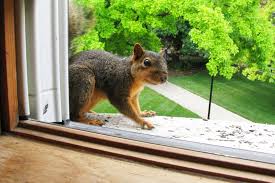
Signs Of Squirrels In Your Home Or Business
Our figures suggest people have more problems with squirrels during the spring and autumn when they’re looking for food.
These are the seven signs easiest signs to spot when looking for evidence of squirrels in your home or loft.
- Scratching and rustling sound from your loft or a wall cavity
- Spotting droppings in the loft – although you might need a pest controller to identify these droppings
- Smell of urine in the loft area might indicate the infestation has been going on some time
- Spotting lots of other squirrels around your property, particularly near your roof or on high fences
- Fruit and nuts being stolen from bird feeders, or the feeders being disturbed/knocked over
- Bark being stripped from trees in your garden
- Holes in vents or damage to your insulation foam.
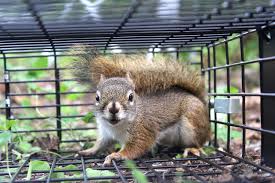
Combination of Traps, Baits, and Repellents
Use a combination of traps, bait boxes, and two different repellents in the same pattern as numbers one and two above, but alternate the traps and bait boxes at random. Sun Tzu, in his seminal work, The Art of War, advises us to know our enemy, in this case, squirrels.
Their natural inquisitiveness will lead them to investigate each time a trap turns up where a bait box used to be and vice versa. Alternating liquid repellents will further confuse the squirrels, increasing the chances of them being funneled into the areas where you’ve set your traps and bait boxes.
An All Repellent Method
An all-repellent option, this one uses the ultrasonic spikes together with multiple liquid repellents to drive the squirrels away from your hard and garden.
The spikes have to stay where you place them. Just make sure that none of them are on the same tempo or beat, thus you always have one or more them sounding while others are quiet.
Spray the repellents around all the trees and poles in the yard as well as around the spikes. Squirrels will sometimes investigate the source of the irritating noise in an attempt to stop it.
Liquid repellents will aid in keeping them away, reinforcing their perception that something bad is taking place and they should head for greener pastures somewhere else.

Squirrel Control Recommendations
- Removal of any diet source: bird seed for example, because they attract the squirrels is the first order of business.
- Using gutter guards and covering downspouts will reduce the number of squirrels that are entering through the rooftop and facia boards.
- Live trapping method of trapping squirrels is the only way to remove unwanted squirrels. Catching a squirrel is really the only way to get rid of squirrels in your attic, once they have chewed holes. It is important to seal up and repair all entry points after trapping the squirrels, so they no longer have access.
- Locate the trap along the path of entry and places of known foraging activity.
- Go about 4-5 miles away to relocate the squirrels, or it will find its way back to your area.
- You may want to consider local ordinances for trapping squirrels, in that they differ. Sometimes a professional trapper with a nuisance control license is needed to not only capture the squirrel but relocate it as well.
How To Get Rid Squirrels In The Attic
The following recommendations combine advice, rules, and tips to hasten the elimination of squirrels from the attic:
- Take away foodstuff, the smell is likely to attract squirrels. Clean the attic from everything that can be used for nesting: paper, old wallpaper, wool things, etc.
- Place your pets’ hairs around the attic. The permanent feeling of an enemy will frighten the pests.
- Dampen cotton cloths in ammonia and place them wherever squirrels can gather. The sharp smell will drive the animals away. After your tattle tails disappear, switch on a ventilator or air ionizer (purifier) to clean the air.
- Place around the attic small cotton balls or pieces of fabric dampened in naphthalene: near boxes, in corners, wherever else you’ve seen rodent activity. To increase the repelling impact, combine it with other types of rodent-repelling substances or essential oils. But be careful: naphthalene is highly flammable and classified as a dangerous fire hazard.
How To Identify Bed Bugs
Preparing Your House for Bedbug Treatments
Bedbugs can be difficult to eliminate when they infest your home unless you do your part by cooperating with the pest control company. The following tips will help YOU and your pest management company get rid of bedbugs quickly:
- Don’t move any of your belongings to another home during or before the treatment unless you know they are not infested. You might spread bedbugs to another home or to your car or workplace in a backpack or box and then re‐infest your home after it has been treated. Move as few items as possible and have them checked for bedbugs (or heat them) before removing them.
- Wash all sheets, blankets, pillowcases, and other bedding in hot water. Place the items in a dryer set on the highest setting that won’t damage the items. Dry the items thoroughly and then place them in trash bags. Keep them separate from items that may be infested.
- Wash all clothing in hot water and then dry on the highest setting allowed for the clothing. Clothing that can’t be laundered and dried (including coats and jackets) can be dry‐cleaned or need to be inspected carefully. Do not place clothing in infested rooms/areas until treatment has been completed and the bedbugs have been eliminated.
- Place curtains, pillows, towels, stuffed animals, etc. in the dryer set on the highest setting that won’t damage the items for at least 30 minutes. Double bag these items immediately after drying.
- Carefully inspect all Items that cannot be washed: books, electronics, picture frames, plastic toys, etc. If insecticides are going to be used, place children’s toys into plastic bags or storage bins (only if they are bedbug free). If heat is used, the pest control company may want these items left in place so they are exposed to the heat treatment.
- Store cleaned and dried items in plastic bags until your home has been treated and the bedbugs eliminated.

What Does a Bed Bug Bite Look Like?
Bed bugs love fast food. They like to feed and then scurry back to their hiding places. They try to avoid crawling all over their food for fear of waking it/us. They usually bite the bare skin they find closest to the mattress. That’s why it’s common to see two or three bite marks in a line along the skin that was in contact with the mattress or pillow. When this happens it’s time to learn how to get rid of bug beds fast.
Everyone reacts differently to a bed bug bite. Some will develop small itchy bumps like mosquito bites; others will suffer from large, puffy red lesions the size of a quarter. A lucky few will have no reaction at all. Other signs of bed bugs are bloodstains on your sheets, pillows and blankets. Are you scratching yet?
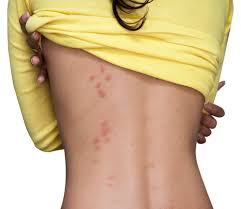
Vacuuming To Capture Bed Bugs
Vacuums can be helpful in reducing the numbers of bed bugs in certain locations especially where there are groups or clusters of bed bugs. Vacuuming is not 100% effective, but will help capture bed bugs. There are some key tips that you should follow to make sure you capture the most bugs possible and that you do not spread the infestation.
- Make sure you make the suction as strong as possible. Use a crevice tool attached to the vacuum. Bed bugs have the ability to cling to fabric and wedge themselves in cracks and crevices.
- Make sure that you concentrate on those areas.
- Do not press to hard against the fabric. There is a chance that you can “flick” bed bugs and eggs off a surface instead of capturing them.
- Bed bugs can survive a trip through a vacuum hose. it is important to remove the bed bugs from the vacuum when you are done so that they do not escape.
- When you are finished, remove the vacuum bag and seal the bag with tape. Then place the vacuum bag into a plastic bag and seal this outer bag. This bag can be disposed in the trash.
- If the vacuum does not contain a bag, empty and discard the contents in a sealed plastic bag. Wash the removable container in hot soapy water to ensure any remaining bed bugs are killed. There is usually a filter attached to this container. This filter will have to be washed, frozen, or discarded and replaced by a new filter. DO NOT use water on electrical components of the vacuum.
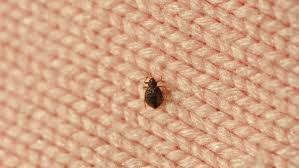
Proper Bagging Technique
The bugs in the bedding or clothing nearby the bed must be quarantined and destroyed using the heat of your clothes dryer. To be sure bedbugs cannot escape from the bags, the bags should be tied as follows:
Step 1: Place items in a large sturdy garbage bag, to fill the bag about ¾ full.
Step 2: Twist the bag as far down as you can.
Step 3: Tie a single knot and tighten it.
Do Not:
- Use twist ties
- Use the ‘easy-tie’ garbage bags
- Use the drawstring type garbage bag
Step 4: Once the fabrics have been put through a dryer for at least 20 minutes, place them in a new bag. Be sure to discard of the old bags immediately in an exterior garbage bin.
Step 5: Do not put clothing back in dresser drawers nearby the bed. It is best to keep the clean clothing in bags in a separate room until the final treatment is completed.
Think you have bed bugs? Here are some dos and don’ts.
DO NOT throw away your mattresses and/or furniture.
Doing so will result in only two things:
- You will waste a lot of money.
- You will make the problem worse because bed bugs and their eggs will spread throughout your home as the furniture is carried out.
DO NOT move yourself or your furniture from room to room.
Bed bugs will not go away if you sleep in another room. Instead, they will follow you and create new colonies wherever you move. Remember:
- Always stay in the same room while your home is being treated for bed bugs.
- If you must move a small item such as a child’s stuffed toy, run it through the dryer at 120 degrees prior to moving it to another room.
DO NOT attempt to treat bed bugs yourself.
Do-it-yourself treatments for bed bugs are ineffective at best, and dangerous at worst.
- Many products that are advertised for home use and sold in hardware stores are not actually safe. Many contain chemicals which can cause physical harm to you and your family members.
- Insecticide sprays and “bombs” WILL NOT kill bed bugs. All they do is cause the bed bugs to relocate. If sprayed, bed bugs will flee the immediate area, meaning they will resettle elsewhere – all over the rest of your home.
DO NOT assume you are the only one being bitten.
People often rule out the possibility of bed bugs because they think no one else in the household is being bitten. Unfortunately, this is faulty logic. If a housemate or family member is not visibly experiencing bites, by no means should you rule out bed bugs. According to the research:
- About 30% of people do not display ANY symptoms when bitten by bed bugs.
- The other 70% exhibit symptoms that range anywhere from barely noticeable, mildly itchy spots to large, painful red welts
DO use bed bug encasements for mattresses and pillows.
Doing so will prevent bed bugs from entering and breeding in your mattress, pillow, or box spring. Conversely, bed bugs that are already inside will be unable to escape and bite you at night.
Vacation Traveler’s Guide To Bed Bugs
Choosing a Pest Management Professional for Bed Bug Control
If you think you may have bed bugs, the first step to manage them is accurate identification. The most important thing to do is make sure the bug in your home is actually a bed bug (Figure 1). There are several other insects that are commonly mistaken for bed bugs. Just because you have skin irritation or bites does not mean bed bugs are the cause. Many insects can bite and cause skin welts and skin irritation.
Do not feel bad if you have bed bugs in your home. Bed bugs can infest any type of house: large or small, neat or messy. They do not discriminate. They affect poor, rich and everyone equally.
If renting, once the bugs have been identified as bed bugs, report it to your landlord immediately. If they are responsible for pest control in the building, they will hire a pest control company to treat the property. If you own a home, the next step is to contact a pest control company.
Some pest control companies have more experience with bed bugs than others. It is important that you interview a few different ones to determine the best. Ask for references and then call them to ask about their experience with the company. See if there are any online reviews (such as the Better Business Bureau or Angie’s List) of the company before you make a final decision.
Use the Following list of questions when calling a pest control company.
Is this business licensed and insured?
The business must be licensed and have insurance.
Are you a member of any professional associations?
Pest control companies that are members of professional associations such as the Oklahoma Pest Control Association or National Pest Management Association are more likely to be better trained.
Has this company provided bed bug treatments in the past?
Make sure that the company has treated for bed bugs successfully in the past and that their pesticide applicators are certified. This is where calling references is helpful.
What methods do you offer for bed bug control?
Likely, the company will offer different treatment methods based on the severity of infestation.
What is your procedure for bed bug jobs?
The procedure will differ with the type of treatment and company chosen. In general, the company will send a pest management professional to do an inspection. After the inspection, they will go through the different treatment options. You will be given a checklist to prepare for the treatment. They will conduct the treatment and should come back two to three weeks later for a follow-up visit and inspection.
Do you have any references I could call?
You can ask for references, but many clients may want to remain anonymous. If they do not have a reference list, look for reviews online.

Tips For Choosing A Bed Bug Exterminator
Bed bug infestations are becoming a real concern for many homeowners, landlords and tenants across the city. They are well known for sneaking into homes unnoticed and spreading like wildfire once they have made themselves comfortable near your bed.
Female bedbugs can lay upwards of 6 eggs per day allowing them to reproduce at alarming rates. Considering how difficult they are to detect and kill, it is a no-brainer that any level of bed bug infestation should only be handled by a professional bed bug exterminator or you risk the chance of making the infestation much more difficult, and expensive, to eradicate.
Choosing a good bed bug extermination company is not as easy as it may seem. Not only do you have to trust them to be in your home alone, you must also confide in their ability to completely exterminate the bed bugs from your home while also keeping your family and pets safe from any dangerous chemicals. To make things easier for you, we have put together some tips on what to look for when hiring a bed bug exterminator
This one seems like common sense but is a very important step in finding the right pest management company to take care of your bed bug problem. Even if a pest management company has a great track record of eliminating other common pests from residential and commercial properties, it does not mean that they will have the same success rate with bed bugs which tend to be the most difficult pest to exterminate
Too many pest control companies claim that they can exterminate bed bugs but in fact do not have the necessary experience with bed bugs to give you the guaranteed results you need. If the bed bug exterminator you choose does not completely eradicate them from your home the problem will become more difficult to solve in the future costing you much more than you had initially planned for
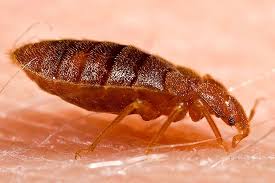
CHOOSING AN INSECTICIDE FOR BED BUGS
Bed bugs are very tough! Most insecticides that are available to the public WILL NOT kill bed bugs. Often the bugs just hide until the insecticide dries up and is no longer effective. Sometimes bed bugs move to avoid insecticides and end up in nearby rooms or apartments.
There are no magic sprays that will get rid of a bed bug infestation. Using a chemical to get rid of bed bugs WILL NOT WORK unless you also remove clutter, clean and launder everything, seal off hiding places, and follow other, non-chemical steps to control bed bugs. Without special training about how and where to apply chemicals, which depends on the specific circumstances, consumers are not likely to effectively control bed bugs with chemicals.
CALL THE PROS!
If chemical controls are going to be used for bed bugs, consumers are strongly encouraged to work with a certified pest control professional.
IF YOU DECIDE TO USE AN INSECTICIDE
Make sure you select an insecticide that is labeled for indoor use. There are very few insecticides that can safely be used indoors, where there is a greater risk of exposure, especially for children and pets. If you use an insecticide that is labeled for garden, outdoor, or agricultural use, you could cause serious health problems for people and pets in your home.
Make sure the insecticide specifically says that it is effective against bed bugs. Most insecticides don’t work at all on bed bugs.
Follow all directions on the insecticide label carefully.
NEVER apply more than the listed amount. If it doesn’t work the first time, applying more will not solve the problem.
Don’t use any insecticide on a mattress or bedding unless the product label specifically says it can be applied there.
Contact Insecticides
There are many different types of liquids, sprays, and aerosols that claim to kill bed bugs. Most state that they “kill on contact.” This sounds good, but it actually means that you have to spray it directly ON the bed bug for it to work. It will not be effective on bugs that are hiding, and it won’t kill eggs either. For most sprays, once it dries it will no longer work.
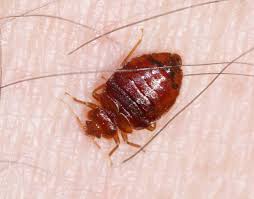
How to get rid of bed bugs
Once a bed bug problem is discovered, you should contact a professional bed bug exterminator for a complete peace of mind. DIY solutions are unlikely to be effective with bed bugs due to the resilience and resistance these blood-sucking pests have built up against conventional treatment methods.
There are however, some out there who may want to attempt it on their own. And for those brave DIYers, while the following tips will not help you fully remove bed bugs from your home, we hope they help reduce the infestation.
Fully inspect the below areas – Bed bugs earned their name for their fondness of beds and bed time. They however, infest many other areas too. These opportunistic insects hide in close proximity to their human hosts so they can sneak out to draw a blood meal without being noticed
Fully inspect the below areas:
Mattress – Be it your bedroom or hotel room, the first thing you should check is the mattress. Apart from live insects found along mattress seams and tags, you may also notice red marks from where bed bugs have been accidentally crushed.
Bed frame – Bed bugs are often found in crevices in between bed frames and mattresses. Look out for small cracks in the frame that bed bugs could live in.
Bedding – Closely inspect the bedding for signs of bed bugs, including pillows, sheets, duvets, etc.
Bedside cabinets – The items closest to the bed are most likely to be infested.
Wardrobes & dressers – Bed bugs are expert hitchhikers and known to be found on clothes.
Pictures – Live bed bug insects have been found on picture frames and other wall adornments.
Furniture – All furniture in the room should be inspected. When inspecting, remove any furniture covers and pay particular attention to the seams and cushions of couches, sofas and chairs.
Wash infested bedding – If your manufacturer’s instructions allow, wash infested bedding at a temperature of at least 140°F for 90 minutes. A typical household washing machine and dryer settings should manage this. Bed bugs cannot survive in a hot dryer longer than 20 to 30 minutes, so dry all bedding on your dryer’s highest heat setting.
Battling Bed Bugs
The resurgence of bed bugs has caused more than the creepy little blood suckers to come out of the woodwork. Some self-proclaimed pest control professionals and marketers are trying to take a bite out of your wallet by peddling products that claim to prevent or remedy bed bug infestations. In fact, the U.S. Environmental Protection Agency (EPA) – one of the federal agencies responsible for managing the bed bug problem – reports an increase in the number of individuals and companies making unrealistic claims about their abilities to control or eradicate the pests.
Bed Bug Basics
Bed bugs are good hitchhikers, riding into homes in and on luggage, furniture, bedding, or clothing. Once inside, the pests like to hide in small cracks and crevices – behind your bed’s headboard, in the seams and tufts of your mattress and inside the box spring, along baseboard cracks, and behind wallpaper. The presence of bed bugs has little to do with cleanliness, although clutter can provide good hiding places and make them difficult to treat.
The Tell Tale Signs of Bed Bugs
Adult bed bugs are oval, wingless and have a rusty red color. They have flat bodies, antennae and small eyes. Check out these photos. They are visible to the naked eye, but often hide in cracks and crevices
Treating Bed Bug Infestations
Experts agree: Bed bug infestations are difficult to control, and no one treatment or technique has been found to be effective in all cases. Still, bed bugs can be controlled through a combination of techniques known as integrated pest management (IPM) – an environmentally sensitive approach that includes prevention, monitoring, and limited use of chemical pesticides. In fact, some populations of bed bugs have developed resistance to common pesticides, making some sprays ineffective. Alternative treatments include heat and steam. Bedding, clothing, and electronic items shouldn’t ever be treated with pesticides, but can be treated with heat.
Do-It-Yourself
If you try to control bed bugs on your own with pesticides, choose products that are intended for that purpose. The EPA has a bed bug product search tool that can help you choose a product that meets your needs.
Try Squirrel Proof Bird Feeders
Tips to Keep Your Home Rodent and Squirrel Free This Fall
Out with the old, in with the new- Are there broken or old and warped attic, dryer or gable vents on the exterior of your home? Now is the time to replace them. Rodents and squirrels have no trouble tearing through vents to enter your attic or home
Don’t hang bird feeders- Bird feeders are prone to both squirrel and mouse feeding. Squirrels are exceptionally good climbers, so breaking into bird feeders is a treat for squirrels. Even if squirrels don’t touch your bird feeders, birds will. Birds fling seeds around, leaving piles on the ground while they feed. Mice and rats flock to this easy food source, attracting them to your property. Next stop? Inside your house.
Seal it up- Take a walk around the exterior of your home. Look for cracks and crevices that can be sealed with foam or stuffed with steel wool. Mice are not able to chew through steel wool, so getting it right the first time is important. Mice have collapsible bodies and can fit through tiny holes and gaps as small as ¼ inch. Once they enter your home, mice nest in wall voids, insulation, attics, under refrigerators, under stoves, and under dishwashers. It’s better to take a proactive approach as soon as you find these vulnerabilities.
Stop using essential oils- They do not work for pest control. If it was this easy, pest control companies would be out of business. If mice or squirrels are getting into your home, the entry point needs to be sealed. Think about it this way. If a bird keeps flying through a broken window in your house, would you spray essential oils onto the broken opening or would you fix the window?
Keep it clean- Sweep up crumbs inside your home on a regular basis. Make sure that you pay close attention to the hard to reach spaces that are easily ignored such as under stoves and under dishwashers. In garages, move bird seed and grass seeds into heavily secured Tupperware or containers.

Choosing a Squirrel Removal Company
Sometimes the best and easiest way to remove a squirrel or exclude it from your property is to hire a company to do it for you. Wildlife removal companies are not well monitored or licensed, so it is up to you to ask questions about a company’s practices before hiring them
A good wildlife removal company should
Provide a customized plan of action and a firm price estimate before you are required to commit
Focus on long-term solutions, such as fixing potential entry points (as opposed to simply removing squirrels)
Guarantee their work (for at least one year)
Know about squirrel behaviour, such as when babies are born and where squirrels are likely to gain entry to a building.
Use only humane live traps (cage traps) or one-way doors to remove animals (rather than leg-hold traps or other harmful capture devices)
Physically check the space for babies, no matter the time of year
Release any live-trapped animals on-site. Never hire a company that moves squirrels to a new location: this is illegal and harmful to the animals. Instead, they should remove squirrels from the nest space and seal the hole to prevent return.
Squirrel Exterminators – Choosing a Pest Control Service
Squirrels look cute and cuddly… until they enter your home. Then they’re not so adorable when you hear sounds coming from your attic, find chewed up stuff, or worse, find droppings everywhere. Finding a company to remove squirrels from your attic, chimney, or other places in your home isn’t as easy as looking up a list of squirrel exterminators and picking one. It’s important to find a pest control service that is experienced with dealing with these quick and sometimes unpredictable little rodents.
The Use of Poisons
Some companies will suggest poisons as a means of squirrel control. Aside from being inhumane, toxic, and potentially dangerous for households with children and pets, consider what happens after the squirrel ingests the poison. It has to die somewhere – and that “somewhere” might end up being inside your house. You then end up with an entirely different problem of how to locate and remove a decomposing squirrel corpse. The smell could attract other wildlife or insects and, of course, is unpleasant to homeowners – particularly if the body is located near the home’s ventilation system. It could be very costly to try to remove the rodent if it has died somewhere particularly hard to access.
DIY vs Professional Help
Sometimes homeowners want to try squirrel removal themselves, before turning to the professionals for any type of extermination service. This is not as easy as it may seem. Even if the homeowner is able to convince the squirrel to leave and then seals up the squirrel’s entry points into the home… how can we be sure that all the squirrels are out?
Choosing a Pest Control Service
An experienced pest control service can help prevent these types of problems from occurring
How much experience do they have with squirrels?
There are many different rodent types, each with its own behaviors. A company that deals with squirrels regularly will be more familiar with what to look for and how to deal with it. Are they able to remove squirrels from different parts of the home – the attic, the chimney, the walls, etc?
WAYS TO ELIMINATE SQUIRRELS IN ATTIC SPACES
Find entry points around the home.They might be cute and fuzzy outdoors, but when you get squirrels in the attic or walls of your home, serious harm and injury can occur. Squirrels can cause damage to your house in places that are very difficult to reach, meaning lengthy and costly repairs. Further, they can transmit quite a few diseases, so an encounter with a frightened and trapped wild animal in your home could spell disaster for you and your loved ones. That’s why it’s important you not only learn how to get rid of squirrels in the attic, but also how to keep squirrels out of attic spaces
Seal up all entry points except one. Squirrels can squeeze through just about any opening in your home, so make sure doors and windows are properly fitted to your house and covered with fitted screens. Wire mesh can be placed over open vents and chimney tops (or you can invest in a chimney cap). Seal up other openings with caulk, steel wool or appropriate materials as needed (e.g., fill up holes with dirt, use bricks to fix a wall, etc.). A pest management professional can help suggest ways to shore up your home’s defense. Just remember to always leave one entry point open so the squirrels can leave on their own. This should be the most obvious and accessible entry point. Cover this last entry point with a single sheet of newspaper, and if it’s still intact a few days after you stop hearing signs of squirrels in the attic, it’s safe to seal it off for good.
Give the squirrels some incentive to leave. Unfortunately, you might have to learn how to get rid of squirrels in your attic by giving them a little push. Squirrels won’t always leave on their own, especially if they’ve already given birth to a litter. In this scenario, the adult will repeatedly leave and enter the home to bring food to the young. If you seal up the final entry point when the adult squirrel leaves while the baby squirrels are still in the attic or walls, they will need to be removed by a pest management professional, dead or alive. To prevent this, drive the squirrels out as soon as they make themselves known, before they can give birth or set up shop. Playing loud music and keeping lights on can be effective as a squirrel repellent. Attics should be avoided while squirrels are in them since they can be dangerous and may even get scared and run into other parts of the house, creating a path of terror and destruction along the way.
Learn how to get rid of squirrels in the attic with traps.Traps are a very effective weapon in the war against squirrels in the attic. There are a few different types of squirrel traps that you can use, as well as a few different places to set them. Live-capture traps do just what their name sounds like: captures the squirrel alive. Unfortunately, you will still have to deal with the live animal after trapping, either through euthanasia or setting it free 5 or 10 miles from your home. This is dangerous to both you and the squirrel and may require a permit based on your state’s wildlife laws. Kill-traps are actually more humane than live traps and much safer, since the rodent will be taken out of the equation quickly and safely. Live traps also have to be checked frequently, as it is inhumane to let the animal starve to death. Both of these types of traps (kill- and live-capture) are typically ‟box traps” and can be placed in attic runways where squirrel activity has been noticed. A third type of trap is called a ‟body-gripping” trap and can be placed directly outside of entry points to catch the squirrel as it darts in and out of your home. Box traps can also be placed outside in the yard, near burrows, to capture squirrels before they can enter your home.
Learn how to keep squirrels out of attics and your home in general. Finally, it’s vital that you take preventative measures to keep not only squirrels, but also pests in general, out of your home. Insects, arachnids, wildlife and reptiles belong outside in nature (unless kept as pets), so start by sealing up entry points around your home (discussed above). Trim any trees that overhang your house, as squirrels and other pests can gain easy access to your roof, windows and attic. If the squirrel population around your home is a problem, use traps to alleviate it. Take necessary precautions if you have children or pets, as they can get caught in the traps as well.

Squirrels
A problem squirrel can destroy insulation, strip the protective coating from electrical wires and can be incredibly destructive to furniture and woodwork (interior and exterior). Squirrel Control is not for amateurs and is best to be handled by a licensed professional. Similarly, raccoons and bats like to nest in the attics of homes and commercial properties and when left unchecked can cause extensive damage.
How long do squirrels live?
Depending on the type of squirrel, some can live upwards of 5 years
What do squirrels eat?
They mostly eat nuts, seeds and fruit
How do you get rid of squirrels?
The best way to get rid of a squirrel in your home (walls, basement, attic) is to trap it and release it somewhere else.
A Brief Brush Up On What You Need To Know About Termite
Things to Know When Choosing A Termite Company
Trusting a company to rid your home of termites can be nerve-wracking. Its common for many companies to promise things they can’t deliver. There’s a lot on the line when you make this decision and you want to be sure you’re making the right one. Here are three things you should know and consider before you choose a termite company.
Do they promise a guarantee?
When you sign up for termite control knowing that a company will deliver on the services they promise can offer you a peace of mind. However, not every company’s services come with a guarantee. Most professional pest control company should offer a guarantee or ensure you that you’ll receive effective services. Before you sign with a company be sure to look over the terms and conditions you’re agreeing to. Look into the fine print and find out if there is a guarantee, and if so find out how long it is good for.
Do they have a good reputation?
When you’re asking friends and family for recommendations don’t forget to do your own research. Suggestions can be a great indicator of good and reliable services, but that doesn’t guarantee you the best results. Check with your local Department of Agriculture or Better Business Bureau to find out if the company you’re interested in has any complaints filed against them. Also find out if the company is a member of your state’s pest control association and the National Pest Control Association. These memberships are important. A company’s connection with these different associations can reveal that they are up to date on the latest pest control technologies and education.
What’s included in the contract?
Take your time, and review multiple proposals from a large number of companies. Review each proposal thoroughly and ensure the company’s plan matches up with your goals from the treatment. Each proposal should include a detailed description of the company’s plan for chemical treatment procedures, copies of insecticide labels, warranties and information on repair or woodwork. Going with the first company you contact takes away your chance to see the range of treatment options available to you.
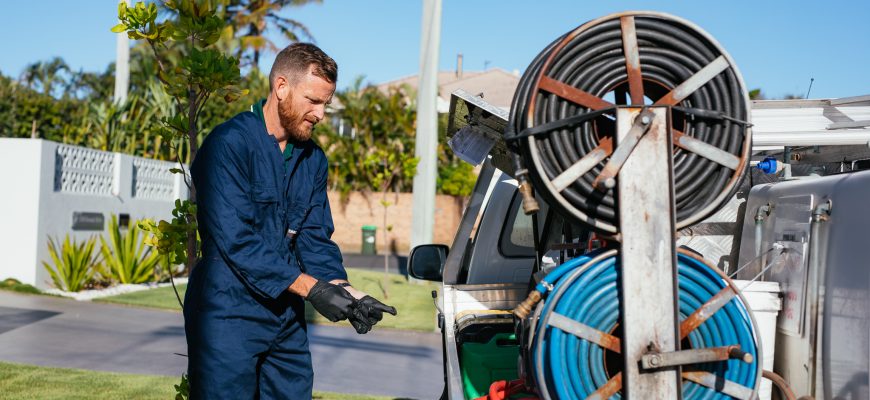
HOW TO CHOOSE THE BEST TERMITE PROTECTION COMPANY
If you suspect your home is infested with termites, you need to act quickly. The longer you wait to address the problem, the more time these winged pests have to establish a foothold and start eating into your home. If you are able to catch the problem early, you may be able to limit the cost of remediation and take back your home in no time. If you wait just a month or two, the problem could become much more difficult to treat. Worse yet, the longer you wait, the more damage will be done to your home.
Hopefully, you are inspecting your home on a regular basis and watching out for signs of a termite infestation. Conducting a monthly termite inspection is important, since it allows you to get a jump on the problem and address it early. Those monthly inspections also give you time to seek out the best termite protection company in town – a process that can take some time.
GO WITH A PEST CONTROL COMPANY THAT HAS THE RIGHT CREDENTIALS.
Before you hire a termite protection company, you will want to make sure that firm holds the required certifications for your state. You can start by contacting the department of environmental protection for your state and asking about licensure. They will be able to provide the information you need or at least point you in the right direction.
MAKE SURE YOU RECEIVE A REALISTIC ESTIMATE.
A quality termite protection company will be willing to provide a firm estimate based on a thorough inspection of your home. The contractor should examine your home thoroughly both inside and out, looking for the warning signs of termites and explaining their process as they go. Watch out for companies that are unwilling to provide a firm estimate.
BEWARE OF COMPANIES THAT CLAIM TO HAVE A SECRET FORMULA TO PEST CONTROL.
Also watch out for contractors who claim to have a secret formula or proprietary information on treating termites. There are a few tried-and-true treatments for termites, and none of them are secret. A quality contractor will be willing to discuss the remediation process in detail and keep you informed every step of the way
How To Choose The Best Termite Company?
The termites are considered the most destructive and invasive insects in the world and they are causing worldwide damage worth of billions of dollars each year. Their damage is estimated at more than 100 million dollars. Even though you might have to spend a little in order to get an inspection or a treatment, it’s still much better than to take no action and have much higher repair bills in the long term. There are plenty of pest control companies out there, and in this article, we will take a look at how to choose the best termite company?
Signs of Termites
1 in 3 homes is affected by termites. Even though they eat silently, they still give signs and it is important to take action from the first moment you notice them. This way you will limit the damage and reduce the costs
How Long Has The Termite Control Company Been Around For?
If you have a serious medical issue, you would want to visit an older doctor with plenty of years of experience and avoid getting a treatment from a beginner or a student. It’s the same when choosing a pest control company. You want one that has been around for many years and that has plenty of years of experience. Look for quality and value
Do They Have The Right Credentials To Do The Job?
Not only that the company needs to have knowledge and experience, but it also needs the right certifications. If the company has them, they are usually presented on their website. You can also contact the department of environmental protection in your area and ask for directions.
How Much Will The Treatment Cost
Of course that every homeowner would like to spend as little as possible. But a company that has prices that are way too low compared to the competition, might be suspicious. If the cost is way too small, it might mean that they are not using the most powerful and effective substances and that eventually the termites will not be destroyed.
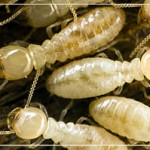
Always Hire the Best Termite Company
Hiring the best Termite Company
When you pick a Termite Company, choose the best termite company carefully. Your relationship may last for years and years.
Many of us view Termite Company inspector/salesmen as we do a used car salesman. Talk fast, say believable things, choose which questions to answer. Get your signature on the bottom line. Believe me, not all are like this, but those types are out there. If you don’t feel comfortable with your inspector/salesman and his presentation, say thank you and simply move on
Having a termite company hassle is just not worth the seemingly best upfront deal, ask questions, be prepared. Know your company, at least a little, before signing on the dotted line. Follow my plan below to help you get the best fit when hiring a termite company
Ask questions when hiring a termite company
During your first face to face contact with a potential company you need to be prepared to ask a few questions. Hopefully the answers you get will allow you make good decisions when hiring a termite company.
Annual Guarantee Renewal
You should have the opportunity to renew your annual guarantee for at least 5 years or more at a fixed yearly premium rate. If you decide to hang on to your coverage, and you probably should, you need to pay the renewal fee each year on or before your treatment anniversary date. Most termite treatments are guaranteed for a one year period with the option to renew for an additional 4 years or longer, that’s up to individual companies..
Choosing a Professional Termite Pest Control Company
Make sure the company offers a guarantee, understand the terms and conditions and how long the guarantee is offered. A good reputation in the market is a good indicator of good service. Check your local Better Business Bureau or Department of Agriculture, to see if complaints have been filed against the potential company you have in mind.
Verify that your selected firm is a member of your state pest control association and the National Pest Control Association. Membership in the National, and state or local pest control associations is a good indicator that the company has access to modern technical information. In the area of termite pest control, their commitment to further education is important, particularly with the newer termite baits and baiting techniques on the market
It is important to request the plan of work revealing sites of termite activity and treatment procedures. Ask for written information on chemical treatment procedures, bait station placements, repair of wood work, warranties, and copies of insecticide labels.
Compare bids before making decisions. Ask about liability insurance.
Follow-up inspections should be included in any termite treatments. Extermination contracts should include annual or semi-annual inspections to verify that a treated home is not reinfested.